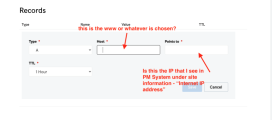Your graphic looks correct. You're creating an "A" record for your subdomain to point to your elastic IP, which should be the same IP that poker mavens is showing you. If poker mavens is showing you a different IP address, you might need to stop the server and restart it for it to pick up the new elastic IP address.
Before you can start with your server, you'll need to follow the instructions here to download OpenSSL and place it on your server so that poker mavens can start up and find it:
https://www.briggsoft.com/pmfaq.htm#q17
And finally, this is an example of how the configuration of poker mavens will look with the certificate files that you download from GoDaddy:
View attachment 849208

